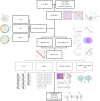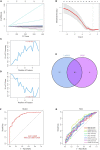Immune-related potential biomarkers and therapeutic targets in coronary artery disease
- PMID: 36684561
- PMCID: PMC9853173
- DOI: 10.3389/fcvm.2022.1055422
Immune-related potential biomarkers and therapeutic targets in coronary artery disease
Abstract
Background: Coronary artery disease (CAD) is a complex illness with unknown pathophysiology. Peripheral biomarkers are a non-invasive method required to track the onset and progression of CAD and have unbeatable benefits in terms of early identification, prognostic assessment, and categorization of the diagnosis. This study aimed to identify and validate the diagnostic and therapeutic potential of differentially expressed immune-related genes (DE-IRGs) in CAD, which will aid in improving our knowledge on the etiology of CAD and in forming genetic predictions.
Methods: First, we searched coronary heart disease in the Gene Expression Omnibus (GEO) database and identified GSE20680 (CAD = 87, Normal = 52) as the trial set and GSE20681 (CAD = 99, Normal = 99) as the validation set. Functional enrichment analysis using protein-protein interactions (PPIs), Gene Ontology (GO), and Kyoto Encyclopedia of Genes and Genomes (KEGG) was carried out on the identified differentially expressed genes. Optimal feature genes (OFGs) were generated using the support vector machine recursive feature elimination algorithm and the least absolute shrinkage and selection operator (LASSO) algorithm. Furthermore, immune infiltration in CAD patients and healthy controls was compared using CIBERSORT, and the relationship between immune cells and OFGs was examined. In addition, we constructed potential targeted drugs for this model through the Drug-Gene Interaction database (DGIdb) database. Finally, we verify the expression of S100A8-dominated OFGs in the GSE20681 dataset to confirm the universality of our study.
Results: We identified the ten best OFGs for CAD from the DE-IRGs. Functional enrichment analysis showed that these marker genes are crucial for receptor-ligand activity, signaling receptor activator activity, and positive control of the response to stimuli from the outside world. Additionally, CIBERSORT revealed that S100A8 could be connected to alterations in the immune microenvironment in CAD patients. Furthermore, with the help of DGIdb and Cytoscape, a total of 64 medicines that target five marker genes were subsequently discovered. Finally, we verified the expression of the OFGs genes in the GSE20681 dataset between CAD patients and normal patients and found that there was also a significant difference in the expression of S100A8.
Conclusion: We created a 10-gene immune-related prognostic model for CAD and confirmed its validity. The model can identify potential biomarkers for CAD prediction and more accurately gauge the progression of the disease.
Keywords: Gene Expression Omnibus (GEO); bioinformatics analysis; coronary artery disease (CAD); immune-related genes (IRGs); optimal feature genes (OFGs).
Copyright © 2023 Liu, Liu, Zhang, Wang and Guan.
Conflict of interest statement
The authors declare that the research was conducted in the absence of any commercial or financial relationships that could be construed as a potential conflict of interest.
Figures







Similar articles
-
Identification of hub genes and their correlation with immune infiltration in coronary artery disease through bioinformatics and machine learning methods.J Thorac Dis. 2022 Jul;14(7):2621-2634. doi: 10.21037/jtd-22-632. J Thorac Dis. 2022. PMID: 35928610 Free PMC article.
-
Identification of a novel immune infiltration-related gene signature, MCEMP1, for coronary artery disease.PeerJ. 2024 Sep 25;12:e18135. doi: 10.7717/peerj.18135. eCollection 2024. PeerJ. 2024. PMID: 39346078 Free PMC article.
-
In Silico Identification of Key Genes and Immune Infiltration Characteristics in Epicardial Adipose Tissue from Patients with Coronary Artery Disease.Biomed Res Int. 2022 Oct 29;2022:5610317. doi: 10.1155/2022/5610317. eCollection 2022. Biomed Res Int. 2022. PMID: 36345357 Free PMC article.
-
Identification of diagnostic biomarkers and therapeutic targets in peripheral immune landscape from coronary artery disease.J Transl Med. 2022 Sep 5;20(1):399. doi: 10.1186/s12967-022-03614-1. J Transl Med. 2022. PMID: 36064568 Free PMC article.
-
Identification of Potential Biomarkers for Coronary Artery Disease Based on Cuproptosis.Cardiovasc Ther. 2023 Jan 25;2023:5996144. doi: 10.1155/2023/5996144. eCollection 2023. Cardiovasc Ther. 2023. PMID: 36743388 Free PMC article.
Cited by
-
Use of Machine Learning for the Identification and Validation of Immunogenic Cell Death Biomarkers and Immunophenotypes in Coronary Artery Disease.J Inflamm Res. 2024 Jan 12;17:223-249. doi: 10.2147/JIR.S439315. eCollection 2024. J Inflamm Res. 2024. PMID: 38229693 Free PMC article.
-
Identification and characterization of interferon-γ signaling-based personalized heterogeneity and therapeutic strategies in patients with pancreatic cancer.Front Oncol. 2023 Oct 24;13:1227606. doi: 10.3389/fonc.2023.1227606. eCollection 2023. Front Oncol. 2023. PMID: 37941546 Free PMC article.
-
Exploring the pathogenesis and key genes associated of acute myocardial infarction complicated with Alzheimer's disease.Sci Rep. 2024 Jan 16;14(1):1449. doi: 10.1038/s41598-024-52094-4. Sci Rep. 2024. PMID: 38228864 Free PMC article.
-
Identification of Endoplasmic Reticulum Stress-Related Biomarkers in Coronary Artery Disease.Cardiovasc Ther. 2024 Jul 3;2024:4664731. doi: 10.1155/2024/4664731. eCollection 2024. Cardiovasc Ther. 2024. PMID: 39742022 Free PMC article.
-
Genetically predicted HLA-DR+ natural killer cells as potential mediators in the lipid-coronary artery disease/ calcification (CAD/CAC) causal pathway.Front Immunol. 2024 Aug 29;15:1408347. doi: 10.3389/fimmu.2024.1408347. eCollection 2024. Front Immunol. 2024. PMID: 39267738 Free PMC article.
References
LinkOut - more resources
Full Text Sources
Miscellaneous

